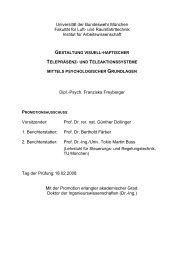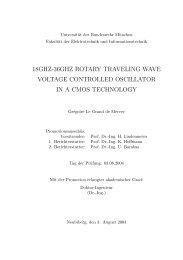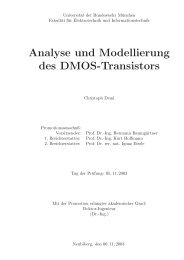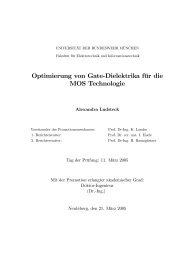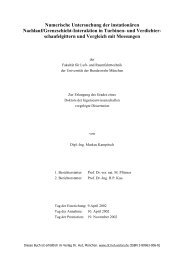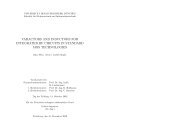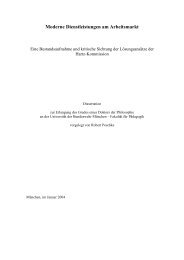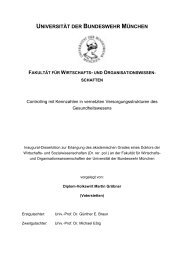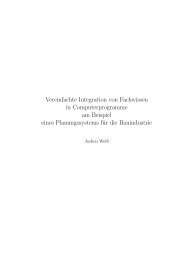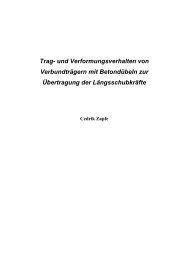Precise Orbit Determination of Global Navigation Satellite System of ...
Precise Orbit Determination of Global Navigation Satellite System of ...
Precise Orbit Determination of Global Navigation Satellite System of ...
Create successful ePaper yourself
Turn your PDF publications into a flip-book with our unique Google optimized e-Paper software.
Chapter 2 Observations <strong>of</strong> <strong>Orbit</strong> <strong>Determination</strong><br />
2.2.2 Doppler<br />
2.2.2.1 Basic Observation Equation<br />
S(t3 )<br />
S(t2 )<br />
S(t 4 )<br />
S 1<br />
r(t 4 )<br />
S 2 S 2<br />
14<br />
S 1<br />
dS<br />
Figure 2-5 Two-Way Doppler Shift<br />
r(t 1 )<br />
S(t 4 -dt)<br />
dS<br />
S(t 1 +dt)<br />
S(t 1 )<br />
One-way Doppler shift is expressed as<br />
f 1 S&<br />
r<br />
1 = ( 1−<br />
)<br />
(2-69)<br />
ft1<br />
c<br />
where<br />
f received frequency (downlink) at transponder<br />
r1<br />
f = f<br />
t1<br />
t<br />
transmitted frequency at satellite<br />
S1 & change rate <strong>of</strong> distance between satellite and ground station for downlink<br />
When the transponder receives the signal and changes it to the coherent frequency ft2 = Kfr1,<br />
then the signal is<br />
returned to the transmitter again. Doppler shift received by the satellite (the transponder) is written as<br />
f 2 S&<br />
r<br />
2 = ( 1−<br />
)<br />
(2-70)<br />
ft<br />
2 c<br />
where<br />
f r2<br />
= fr<br />
the received frequency (uplink) at the satellite<br />
f t2<br />
the transmitted frequency at the transponder<br />
S2 & change rate <strong>of</strong> distance between satellite and ground station for uplink<br />
From Figure 2-5,<br />
1<br />
1<br />
2<br />
1<br />
2<br />
T<br />
1<br />
2<br />
1<br />
2<br />
S = || r ( t ) − S ( t ) || = {[ r ( t ) − S ( t )] [ r ( t ) − S ( t )]}<br />
(2-71)<br />
T<br />
1<br />
2<br />
S2<br />
= || r ( t4)<br />
− S ( t3)<br />
|| = {[ r ( t4)<br />
− S ( t3)]<br />
[ r ( t4)<br />
− S ( t3)]}<br />
(2-72)<br />
T<br />
dS1<br />
[ r(<br />
t1)<br />
S ( t2)]<br />
[ r&<br />
&<br />
( t1)<br />
S ( t2)]<br />
S&<br />
−<br />
−<br />
1 = =<br />
dt<br />
S1<br />
(2-73)<br />
T<br />
dS2<br />
[ r ( t4)<br />
S ( t3)]<br />
[ r&<br />
&<br />
( t4)<br />
S ( t3)]<br />
S&<br />
−<br />
−<br />
2 = =<br />
dt<br />
S<br />
(2-74)<br />
2<br />
Using Eq.(2-69), Eq.(2-70) becomes<br />
S&<br />
2<br />
S&<br />
2 S&<br />
1 S&<br />
2<br />
fr 2 = fr<br />
= ft<br />
2(<br />
1−<br />
) = fr1K<br />
( 1−<br />
) = ftK<br />
( 1−<br />
)( 1−<br />
)<br />
(2-75)<br />
c<br />
c<br />
c c<br />
Eq.(2-75) can also be rewritten as



